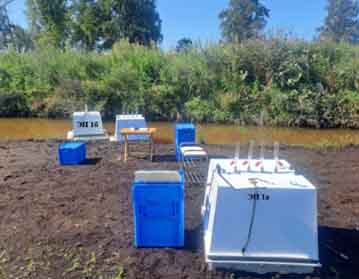Balance greenhouse gas fluxes from the Belarus peat deposits used for industrial peat extraction
DOI:
https://doi.org/10.31251/pos.v8i4.324Keywords:
торфодобыча, дренажные каналы, парниковые газы (СО2, СH4, N2O), ИК-спектроскопия, газовая хроматография.Abstract
The aim of the study Spatial and temporal dynamics of greenhouse gases from the peat of Belarus used for industrial peat extraction to obtain new coefficients of basic CO2 emissions aimed at improving the monitoring, reporting, verification and transition to the 2nd higher inventory level compared to the currently used 1st by "default".
Location and time of the study. The research was carried out in the peat-producing fields of the Grichino-Starobinsky peat deposit (cadastral number 1186) of the Soligorsky district of the Minsk region in the period from May to September in 2022-2024.
Methods. The IR spectroscopy method was used for daily instrumental measurements of CO2 at thematic calibration and reference sites in real time from the main surface of peat extraction fields using a LI-COR LI-820 gas analyzer. The static chamber method was used to measure the balance fluxes of climatically active greenhouse gases CO2, CH4, N2O from channels of the drainage system of peat extraction fields. In-house processing of the results of field instrumental measurements was carried out using software from CAMPBELL SCIENTIFIC (Australia) and a Chromatek-Kristall 5000.2 gas chromatograph (Russia) with electron capture and flame ionization detectors for CO2, CH4, N2O.
Results. For the first time in Belarus, new data on CO2 emissions from peat used for industrial peat extraction during the measurement season of May-September 2022-2024 have been obtained using real-time IR spectroscopy at the Grichino-Starobinsky test site. It was found that the total specific CO2 emissions over the 3-year measurement period amounted to 10,33 t/ha, including 3,46 t/ha in 2022, 5,61 t/ha in 2023, and 1,26 t/ha in 2024. The main factors influencing CO2 emissions are the temperature regime and the UGV level. Thus, the maximum emissions occurred in 2023, due to abnormally high temperatures and low moisture content of the peat deposit. On the contrary, the lowest values of CO2 emission coefficients were recorded in 2024 due to flooding of the reference sites with groundwater and the resulting anaerobic conditions. The spatiotemporal dynamics of CO2 emissions by month for the entire study period were: 1,14 t/ha; 1,26 t/ha; 3,21 t/ha; 2,63 t/ha and 2,09 t/ha, respectively, in May, June, July, August and September.
Conclusions. The presented results on CO2 emissions were obtained under the conditions of the established baseline scenario of peat deposits used for industrial peat extraction, and are aimed at creating standardized baseline indicators of greenhouse gas emissions in the real conditions of modern peat extraction. This approach has the potential to reduce transaction costs, increase transparency, objectivity, and predictability. The reference base coefficients can also serve as a basis for creating estimated and predictive spatial models of greenhouse gas emissions from the peatlands of Belarus in modern conditions of their anthropogenic development. Currently, based on the research results, a technology for remote monitoring of greenhouse gas emissions has been developed, implemented by the information support software package, which has passed the 2nd stage of trial operation (Act dated 03/25/2025) and will be transferred to the Ministry of Natural Resources of the Republic of Belarus for use in their practical activities.
Downloads

Downloads
Published
How to Cite
Issue
Section
License
Copyright (c) 2025 The Journal of Soils and Environment

This work is licensed under a Creative Commons Attribution 4.0 International License.






